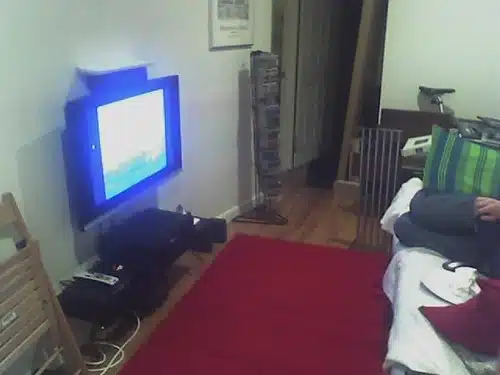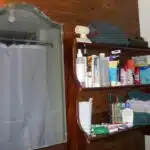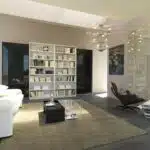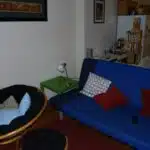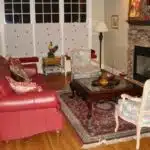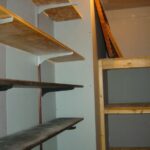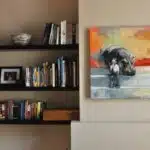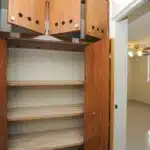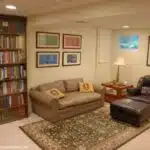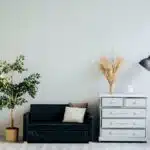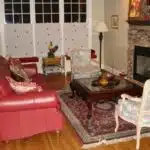Decorating around a TV on a wall can be challenging for many homeowners. A television is often the focal point of a room, and it can be difficult to incorporate it into the overall aesthetic of the space without it feeling out of place or overwhelming. However, with some thoughtful planning and creative ideas, it is possible to seamlessly integrate your TV into your home decor.
One important consideration when decorating around a TV on a wall is choosing the right placement. The location of your TV can impact the flow and balance of the room, so it’s important to think carefully about where you want it to be. Additionally, incorporating other elements such as artwork, shelving, or decorative accessories can help to soften the look of the TV and make it feel more like an intentional design choice rather than a necessary eyesore. In this article, we will explore some tips and tricks for decorating around a TV on a wall that will help you create a cohesive and stylish living space that serves both form and function.
Choosing The Right Tv Placement
When it comes to decorating around a TV on a wall, choosing the optimal viewing placement is key. One of the primary considerations is minimizing glare, which can be achieved by positioning the TV perpendicular to any windows or light sources. Additionally, placing the TV at eye level when seated is important for comfortable viewing.
Another factor to consider when selecting the ideal location for your TV is adjusting for room size. A large screen in a small room can be overwhelming, while a small screen in a large room can feel underwhelming. The general rule of thumb is that your TV should take up no more than 30% of your wall space and should be positioned at an appropriate distance from seating areas.
Ultimately, finding the perfect spot for your TV requires striking a balance between comfort and aesthetics. In the next section, we’ll explore how you can create a visually appealing gallery wall around your television while still maintaining optimal viewing conditions.
Creating A Gallery Wall
Creating a Gallery Wall:
One of the most effective ways to decorate around a TV on a wall is by creating a gallery wall. This approach not only directs attention away from the television but it also adds visual interest to the room. To start, select art pieces that complement the overall decor scheme of your room. Mixing textures and playing with color palettes can help create depth and intrigue in your gallery wall.
When selecting artwork for your gallery wall, consider incorporating different sizes and shapes to add diversity. You can also experiment with different framing styles to achieve a cohesive look. If you have a large blank wall, consider creating a symmetrical arrangement using an odd number of pieces. Alternatively, if you have limited space, you can create an asymmetrical display by playing with varied heights and spacing.
Incorporating floating shelves into your gallery wall is another great way to add dimension and depth to your decor. These shelves offer additional storage space while still keeping your artwork at the forefront of your design. When arranging items on floating shelves, remember to mix textures and colors just as you would with the artwork on your walls. By combining these elements, you can create a cohesive and visually appealing display that enhances both the TV and the overall decor scheme of your home.
Incorporating Floating Shelves
One of the most popular ways to decorate around a TV on a wall is by incorporating floating shelves. Floating shelves are versatile, practical, and aesthetically pleasing. They are perfect for displaying decorative items such as vases, picture frames, books, and plants. However, some people may have concerns about the safety of installing floating shelves over their TV. While it is true that you need to be cautious when installing them, there are ways to ensure they are secure.
Floating shelf styles vary widely in terms of materials, colors, and designs. You can choose from rustic wooden shelves to sleek metal ones or opt for colorful acrylic floating shelves. The options are endless! When selecting your floating shelves, it’s essential to consider the overall style of your room and your personal taste. Once you’ve chosen your floating shelf style, it’s time to think about how to style them. Here are some tips for styling shelves:
- Group items in odd numbers: Grouping items in odd numbers creates balance and visual interest.
- Mix textures: Combining different textures will add depth and dimension to your display.
- Vary heights: Play with different heights when arranging items on your floating shelves.
By incorporating these tips into your decorating strategy, you’ll create a visually stunning space that complements your TV rather than detracts from it.
Adding decorative accessories is the next step in creating an inviting atmosphere around your TV. Once you’ve installed your floating shelves and styled them with decorative items such as books and picture frames, it’s time to add additional decorations around the TV area itself. This could include adding a statement piece of art above the TV or placing a decorative tray on an ottoman below the TV. By layering various decorative elements around the TV area, you’ll create a cohesive look that ties everything together beautifully.
Adding Decorative Accessories
- Hanging artwork around a television mounted to the wall can create a visually appealing and balanced look.
- Selecting artwork that complements the color of the wall and the television can help create a unified design aesthetic.
- Incorporating shelves around the television can also help to create visual balance, as well as provide additional storage for small items.
- When selecting shelves to use, consider selecting those that are thin and lightweight in order to avoid detracting from the focal point of the television.
Hanging Artwork
When it comes to decorating around a TV on a wall, hanging artwork is one of the most effective ways to add character and personality to the space. Consider selecting pieces that complement the colors in your room, while also mixing textures for added depth and interest.
Choosing complementary colors can be a great way to create balance in your design. If you have a neutral color scheme, consider adding pops of color through your artwork. On the other hand, if you have bold or vibrant walls, opting for more subdued artwork can help tone down the overall look of the space.
Mixing textures is another way to create visual interest when hanging artwork around your TV. Incorporating different materials such as wood, metal or fabric can help break up an otherwise flat wall. Ultimately, selecting artwork that speaks to your personal style and preferences will ensure that you’re able to create a cohesive and visually pleasing space in which to enjoy movies and shows.
Adding Shelves
When it comes to decorating around a TV, adding shelves is another effective way to add personality and style to the space. Floating or built-in shelves can be used to display decorative accessories such as books, vases, and plants. One advantage of floating shelves is their versatility, as they can be easily moved and rearranged as needed. On the other hand, built-in shelves provide a more permanent and streamlined look.
Choosing between colorful or neutral decor for your shelves will depend on your personal preferences and the overall color scheme of your room. If you have neutral walls and furniture, adding colorful accessories can help bring life and vibrancy to the space. Alternatively, if you have bold or vibrant walls, opting for more neutral decor on your shelves can help balance out the overall look of the room.
Mixing textures when styling your shelves is also important in creating a visually interesting display. Incorporating different materials like wood, glass, or metal can add depth and dimension to your space. Additionally, playing with varying heights of objects on your shelves can create an eye-catching display that draws attention away from the TV itself. Ultimately, adding decorative accessories like shelves can transform a plain wall into a stylish and functional part of your home’s decor.
Hanging Artwork Around The Tv
Adding decorative accessories and artwork around a TV on a wall can help to create an aesthetically pleasing space. However, it is important to consider the artwork placement and color coordination before hanging them up. One idea is to hang multiple pieces of art around the TV in a symmetrical or asymmetrical arrangement. This adds balance and contrast to the space.
Another way to decorate around a TV is by layering pieces, creating depth. This can be achieved by using different sizes and shapes of frames to add dimension to the space. A popular technique is creating a gallery wall with similar or complementary colors for a cohesive look. This technique works well if you have limited wall space as it allows you to display multiple pieces of art in one area.
Using a console table is another great way to decorate around your TV on the wall. It not only provides storage but also creates an opportunity for displaying decorative items such as vases, candles, and books. The height of the console table should be considered when styling it with decorative objects as it should be proportionate with the height of the TV on the wall. By following these tips and tricks, you can create an inviting and beautiful space that showcases your personal style while still keeping functionality in mind.
Using A Console Table
Console Table Styling
Another option for decorating around a TV on a wall is to use a console table. A console table can add both style and function to your living room. When choosing a console table, consider the color and material of your existing furniture. If you have a neutral-colored sofa, choose a console table that contrasts with it. On the other hand, if you have bold-colored furniture, a neutral-colored console table may be the better choice.
Once you’ve chosen your console table, it’s time to start styling it. Add some decorative items such as vases or picture frames to create visual interest. Layering different textures and heights can also make the space more visually appealing. You can also place books or magazines on the surface for an added touch of personality.
Choosing Console Table Color
When selecting your console table color, consider the overall color scheme of your living room. If you have mostly warm-toned furniture, choose a warm-toned wood like oak or cherry for your console table. Conversely, if you have cool-toned furniture such as gray or blue sofas, then opt for cooler-toned woods like maple or ash.
Incorporating these tips will help you achieve a cohesive look in your living room space while adding function and style with a chic console table. In our next section, we’ll discuss how to install built-in shelving to further enhance your living room’s decor.
Installing Built-In Shelving
- When measuring for built-in shelving, it is important to take accurate measurements to ensure the shelves fit properly and securely on the wall.
- Once the measurements have been taken, the next step is to install the shelves according to the manufacturer’s instructions.
- After the shelves have been installed, they may need to be sanded, painted, or stained for a finished look.
- Wall anchors can be used to ensure the shelves are securely attached to the wall.
- After the shelves have been finished, decorative elements such as books, plants, and art can be added to the shelves for a personal touch.
- The final step is to make sure the shelves are level, as any uneven shelves may be unsightly and may not hold the desired items properly.
Measuring For Shelving
Decorating around a TV on a wall can be challenging, but adding built-in shelving can provide both storage and interest to the space. One important step in installing built-in shelving is measuring for the shelves. Properly measuring the wall space and choosing the right shelving style are crucial for creating a cohesive and functional design.
Begin by measuring the wall space where you plan to install the built-in shelves. It’s important to take into account any obstacles such as light switches or electrical outlets. Once you have your measurements, decide on a shelving style that complements your décor and meets your storage needs. A popular option is floating shelves, which create a modern and streamlined look.
When choosing a shelving style, consider how it will interact with your TV placement. You want to ensure that the TV remains the focal point of the room while also incorporating the shelves seamlessly into the design. One option is to flank the TV with symmetrical shelves, creating balance in the space. Another option is to incorporate asymmetrical shelving for an eclectic and unique look.
Measuring for built-in shelving may seem like a daunting task, but taking time to properly measure wall space and choose a complementary shelving style will result in a cohesive design that enhances both functionality and aesthetics. With careful planning and attention to detail, adding built-in shelves around a TV can elevate any living space into an inviting and functional room.
Installing Shelving
Now that you have measured for your built-in shelving, it’s time to move on to the installation process. Installing DIY shelving can be a challenging but rewarding task. Before beginning, gather all necessary tools and materials, including a level, drill, screws, and brackets.
When installing the shelves, it’s important to follow proper anchoring techniques to ensure they are secure and able to hold the weight of your items. Start by marking the locations where you will install the brackets using a level to ensure they are straight. Then, drill pilot holes in the marked locations before screwing in the brackets.
Once the brackets are securely in place, it’s time to add the shelves. Start by measuring and cutting your shelves to fit within the bracket dimensions. Then carefully place them onto the brackets and secure them with screws if necessary. With these styling tips in mind, you can create a functional and aesthetically pleasing addition to any room with DIY built-in shelving.
Finishing Shelves
With the installation of your built-in shelving complete, it’s now time to turn your attention to finishing shelf styling. A well-styled shelf can elevate the look of any room and showcase your personal style. There are countless ways to style shelves, from minimalist and modern to eclectic and colorful. The key is to find a balance between function and aesthetics.
One way to achieve a cohesive look is by using color coordination. Grouping items by color can create a visually pleasing display that ties the room together. Another option is to play with texture and shape. Mixing different textures such as wood, metal, or glass can add depth and interest to your shelves.
DIY shelf makeovers are also an inexpensive way to update the look of your shelves without having to replace them entirely. Consider adding wallpaper or contact paper behind the shelves for added visual interest, or painting them a bold color for a pop of personality. With these finishing shelf styling tips in mind, you’ll be able to transform your built-in shelving into a functional and stylish addition to any space.
Creating A Feature Wall
A feature wall is a fantastic way to spruce up a bland living room and add some personality to your space. It’s like putting on a statement necklace or bold lipstick – it elevates the entire look. A feature wall draws attention to itself, and all eyes will be on it as soon as you enter the room.
When creating a feature wall around your TV, it’s essential to consider color schemes that complement the TV’s aesthetics. Neutral colors such as white or grey work well with most TVs, but if you want something more eye-catching, go for a bold color that contrasts with the TV’s frame. Lighting design is also crucial in creating an inviting ambiance. Choose soft lighting fixtures that highlight both the television and the feature wall.
Here are some additional tips when creating a feature wall:
- Choose complementary artwork or decor pieces that enhance the overall look of your living room.
- Use texture to add depth and dimension to your space. Consider adding wall panels or textured wallpaper.
- Experiment with different shapes and patterns to create a dynamic visual effect.
- Keep in mind that less is often more when it comes to decorating, so avoid over-cluttering your space.
- Do not forget about functionality; make sure your feature wall does not obstruct any doors, windows or walkways.
Creating a stunning feature wall can elevate your space from drab to fab instantly. However, do not underestimate the power of nature when it comes to home decorating. Incorporating plants into your living room’s decor can add a touch of freshness while improving air quality and reducing stress levels. In the next section, we will explore ways to incorporate plants into your living room decor seamlessly.
Incorporating Plants
After creating a feature wall in your living room, it’s time to think about how to decorate around the TV on that wall. The TV is often the focal point of any living room and can be tricky to style around. However, with some creativity and a few simple tips, you can make your TV area look stylish and put together.
One way to style around the TV is by incorporating plants into the space. Plant placement can help soften the look of the TV area while adding some natural beauty to your living room. Consider placing potted plants or hanging planters on either side of the TV or placing a large plant on a stand next to it. Not only will this add visual interest, but plants also provide numerous benefits such as purifying the air and reducing stress levels.
When it comes to plant maintenance tips, make sure you choose plants that are low-maintenance and thrive in low-light conditions since they will likely be placed indoors. Some great options include snake plants, pothos, and ZZ plants. Be sure to water them regularly and give them proper lighting for their specific needs. With just a little bit of care, your plants can thrive and provide an elegant touch to your TV area.
Adding a statement rug is another great way to decorate around the TV on your living room wall. A rug can help anchor the space and tie everything together while providing some much-needed texture and color. Consider choosing a bold patterned rug that complements your existing decor or opting for a plush shag rug for added comfort. Whatever style you choose, make sure it’s large enough to extend beyond the edges of your seating area for maximum impact.
Adding A Statement Rug
Decorative rugs can be an excellent addition to any room. They can add color, texture and a sense of warmth to your space. When considering a rug for your TV wall, it is important to choose one that compliments the overall décor of the room. There are many decorative rug styles available such as Persian, Oriental, and modern rugs that could enhance your wall.
One of the most important things to consider when placing a rug in a room with a TV is the size and placement of the rug. The rug should be large enough to anchor and define the seating area but not so large that it covers too much floor space, which can make the room look smaller. A good rule of thumb is to leave at least 18 inches of bare floor between the edge of the rug and walls or other furniture.
When placing a rug in front of a TV on a wall, it’s best to position it so that the front legs of all seating face onto the rug while leaving some space around it. This creates an inviting and cozy atmosphere while creating visual boundaries for your seating arrangement. By following these simple tips for selecting and placing your decorative rugs around your TV wall, you can create an inviting atmosphere that complements both your style and functionality.
Moving forward, if using a tv stand is more appealing than hanging your television on a wall, there are many versatile options available which will suit any home decor style.
Using A Tv Stand
As if decorating around a TV on a wall weren’t challenging enough, maximizing space in the living room can be a daunting task. But fear not, as storage solutions can come in handy when it comes to making the most of your space. Consider multi-functional furniture pieces that offer both storage and style. A coffee table with built-in drawers or shelves can be used to stash away remotes, magazines, and other living room essentials.
Another storage solution is using bookshelves or floating shelves to display decorative items while keeping clutter at bay. These shelves can also serve as an alternative to traditional TV stands and offer plenty of space for storing media consoles or DVDs. Just make sure to keep the area around the TV tidy by concealing cords and cables.
If you’re looking for a way to hide your TV when it’s not in use, consider installing a sliding panel over it. This panel can be made from materials like reclaimed wood or metal and can add a touch of rustic charm or modern elegance to your living room decor. When closed, the panel serves as a piece of art or statement wall feature, but when open, it reveals your TV without taking up any additional space.
Incorporating these storage solutions into your living room decor will not only help you maximize space but also add functionality and style to your home. So go ahead and get creative with your storage options while keeping in mind that organization is key when it comes to decorating around a TV on a wall.
Hiding The Tv With A Sliding Panel
A sliding panel is a great way to hide your TV when it’s not in use. There are several sliding panel alternatives that you can choose from, including custom-made panels, pre-fabricated panels, and DIY options. Custom-made panels can be expensive, but they offer a seamless look that blends in with your decor. Pre-fabricated panels are more affordable and come in various sizes and designs.
If you’re looking for a fun project, consider making your own DIY sliding panel. This option allows you to customize the size and design of the panel to fit your needs. You’ll need some basic tools and materials like wood, hinges, and paint or stain. There are many online tutorials available to guide you through the process step-by-step.
A sliding panel is not only functional but also adds a unique element of design to your space. Whether you opt for a custom-made panel, pre-fabricated panel, or DIY option, it’s important to ensure that it complements the rest of your decor. A sliding panel can be an excellent focal point in your room or seamlessly blend into the background. In the next section, we will discuss how to create a bookshelf display around your TV for an even more stylish look.
Creating A Bookshelf Display
- When choosing books to display on a bookshelf, it is important to take into consideration the size, color, and style of the books in order to create a cohesive look.
- Books should be arranged on the shelf in a way that creates a visually appealing pattern; this can be done by alternating between larger and smaller books, or by grouping books of similar sizes, styles, and colors together.
- To further enhance the display, decorative items such as plants and sculptures can be added to the shelves.
- When selecting decorative items, it is important to consider the color, texture, and size of the items in order to ensure that they complement the books.
- Careful thought should also be given to the placement of the items on the shelves; for example, it may be best to place smaller items at the front and larger items at the back.
- Finally, the display should be adjusted and rearranged as needed in order to ensure that the bookshelf looks its best.
Choosing Books
Creating a bookshelf display is not just about arranging books. It’s an opportunity to add personality and style to any room in your home. While it may seem overwhelming at first, there are a few simple steps you can follow to create an aesthetically pleasing display that reflects your interests and taste.
When choosing books for your bookshelf display, it’s important to consider both the book arrangement and color coordination. Start by grouping books together by topic or genre. Then, arrange them by size, with larger books on the bottom and smaller books on top. To add visual interest, try stacking some of the books horizontally or alternating their placement vertically. Once you have arranged your books, consider their colors. Group similar colored books together or create a rainbow effect by arranging them in order of the color spectrum.
Color coordination is not limited to just the books themselves – think about how they will complement other items on your shelf or in the room. Incorporate decorative objects such as vases, picture frames, or sculptures that complement the color scheme of your bookshelf display. Place these objects strategically throughout the shelves to break up the monotony of rows of books and add depth and texture to your display. Remember that creating a bookshelf display is all about personal expression – don’t be afraid to experiment until you find what works best for you!
Arranging Books
Creating a stunning bookshelf display is a perfect way to add personality and style to any room in your home. Apart from the decorative objects, color coordination, and texture, arranging books plays an essential role in creating a visually appealing display. The technique of arranging books can either make or break the overall look of your bookshelf display. Therefore, it is crucial to consider color blocking and minimalist styling when organizing books.
When arranging books for your bookshelf display, it is vital to group them together by topic or genre. This method not only makes it easier to find specific books but also helps create a cohesive look. Additionally, arranging books by size with larger ones at the bottom and smaller ones on top helps create balance on your shelf. To add visual interest, try alternating between vertical and horizontal stacking of similar-sized books.
Color blocking is another effective technique when organizing your bookshelf display. Grouping books together by their colors creates a visually pleasing effect that adds depth and texture to your shelf. You could even go as far as creating a rainbow effect by arranging them in order of the color spectrum. Color coordination should not be limited to just the books themselves; incorporating decorative objects that complement the color scheme of your bookshelf adds more dimension and character to your space.
In conclusion, arranging books is an essential factor when creating a beautiful bookshelf display that reflects your interests and taste. It’s all about personal expression – don’t hesitate to experiment until you find what works for you! Incorporating techniques such as color blocking and minimalist styling will help you achieve an aesthetically pleasing look while maintaining functionality.
Adding Decorative Items
In addition to arranging books, incorporating decorative items into your bookshelf display can elevate the overall aesthetic of your space. One way to add a touch of elegance is by using wall sconces to illuminate your books and decorative objects. These light fixtures not only provide additional lighting but also create a cozy atmosphere for reading or relaxing in your room.
Another way to add dimension and depth to your bookshelf display is by incorporating mirrors. Mirrors reflect light and make small spaces appear larger, creating an illusion of more space. Additionally, they add a touch of glamour and sophistication to any room. Mirrors come in various shapes, sizes, and styles – from classic round or rectangular ones to trendy geometric designs – making it easy to find one that complements your personal style.
When selecting decorative items for your bookshelf display, it’s essential to consider their color scheme, texture, and shape. Incorporating items such as vases, figurines, or plants adds interest and character while maintaining balance on the shelf. Also, don’t be afraid to mix and match materials such as wood, metal, glass or ceramics; this creates contrast and makes each item stand out on its own. With these tips in mind, you can create a visually stunning bookshelf display that reflects your personality while adding charm and sophistication to any room in your home.
Using A Statement Wallpaper
A bold wallpaper can be a great way to decorate around a TV on a wall. Just like how a beautiful frame enhances the artwork inside it, a statement wallpaper can add character and depth to your space. It is important to choose the right wallpaper that complements the color scheme of your room. If you have a neutral colored room, consider adding a pop of color with your wallpaper. On the other hand, if your room already has bold colors, opt for a more subtle pattern.
Color coordination is key when using statement wallpaper. You want to make sure that it doesn’t clash with any other design elements in your space. One strategy could be to use the colors from the wallpaper as inspiration for accent pieces such as throw pillows or curtains. This creates cohesion in the room and makes everything feel intentional and put-together.
Incorporating bold wallpaper into your décor adds personality and style to an otherwise bland wall. However, it is important not to overdo it with too many patterns and textures in one space. A good rule of thumb is to limit yourself to one statement piece per room. Next, we will explore another option for decorating around your TV – adding textured wall panels.
Adding Textured Wall Panels
Using a Statement Wallpaper is an excellent way to add character and personality to your living room. However, if you want to take your TV wall design to the next level, Using Textured Wall Panels can be a game-changer. Textured panels come in various materials such as wood, brick, stone or concrete and can give your living room the desired depth and richness it needs.
When incorporating textured wall panels into your TV wall design, it’s essential to consider the size of the panels. Large panels work well in spacious rooms with high ceilings while smaller ones are perfect for more compact spaces. Additionally, ensure that the colors and textures of the panel complement those of your furniture and décor pieces.
You can also play around with lighting when using textured wall panels on your TV wall. Adding some recessed lighting behind the panel can create a stunning focal point that adds warmth and interest to your living room. Overall, Using Textured Wall Panels is an excellent way to enhance your living room décor while drawing attention away from the TV screen.
Conclusion
When it comes to decorating around a TV on a wall, there are several ways to make it blend seamlessly into your home decor. Start by choosing the right placement for your TV, taking into account the size and layout of the room. From there, consider creating a gallery wall or incorporating floating shelves to display decorative accessories.
Hanging artwork around the TV or using a sliding panel to hide it can also be effective options. For those who prefer a more functional approach, creating a bookshelf display is an excellent way to add both storage and visual interest. Additionally, statement wallpaper or textured wall panels can add depth and dimension to any space.
As a home decorating expert, I recommend experimenting with different techniques until you find the perfect solution for your unique space. Remember that decorating around a TV should be fun and creative, so don’t be afraid to get creative with your design choices. By following these tips and considering your personal style preferences, you can create a beautiful and cohesive space that incorporates your favorite entertainment technology seamlessly into your home decor.
Image Credits
- “TV on the wall” by TenSafeFrogs (featured)

